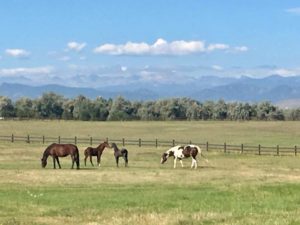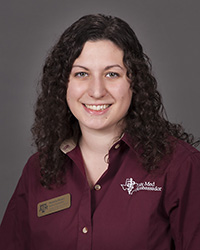
Recently, 10 Texas A&M veterinary students, including myself, traveled to Phoenix, Arizona, for the 51st annual American Association of Bovine Practitioners (AABP) Conference. As if simply attending my very first AABP conference wasn’t exciting enough, three fellow third-year veterinary students and I had the opportunity to compete in the Quiz Bowl competition!
The Quiz Bowl is bracket-style competition, during which students must not only be well-versed in a variety of bovine veterinary medicine related topics, but also have lightning-fast fingers in order hit the buzzer before another team does! While our team, unfortunately, did not advance out of the first round (congratulations to University of Georgia for winning our round and the entire competition!), it was still a very fun, worthwhile experience and I am proud of our team!
The AABP Conference also offered a trade show with more than 100 exhibitors ranging from pharmaceutical and ultrasound companies to our very own Texas A&M Veterinary Medical Diagnostic Laboratory! The most beneficial part of the trade show, for me, was learning about a student loaner ultrasound program, through which students can request to borrow an ultrasound for use during a two-week externship. As someone who plans to practice dairy medicine, the opportunity to have substantial reproductive ultrasound experience prior to graduating from vet school is HUGE and I am so excited about taking advantage of this opportunity.
When not wandering around at the trade show, talking to company reps and snagging some cool freebies, you could likely have found me sitting in on the dairy sessions. What was neat about the AABP conference is that they offered concurrent dairy, beef, practice-management and student sessions—something to pique everyone’s interest! Talks on the use of thoracic ultrasound to monitor lung health in dairy calves, antimicrobial stewardship (presented by Texas A&M’s own Dr. Virginia Fajt), and field necropsy were just some of the many diverse topics aimed at equipping us to embody this year’s conference theme to “Become Indispensable.”
Another highlight of the conference was the opportunity to reconnect with friends made at past externships, as well as meet other students and veterinarians. We came to Phoenix from all over the country, but we all have one thing in common—we are proud to be future and current bovine practitioners and will continue to strive to do the best job we can protecting the beef and dairy industries.
The countdown is on for next year’s AABP conference in St Louis, Missouri! 🙂


 The more time I spend in vet school, the more I’m in awe of the passage of time. Perhaps it’s just growing older or the realization that I’ve just experienced my last “summer break,” but it has become more striking than ever that time simply flies by.
The more time I spend in vet school, the more I’m in awe of the passage of time. Perhaps it’s just growing older or the realization that I’ve just experienced my last “summer break,” but it has become more striking than ever that time simply flies by. It was exciting, though, to speak with a fourth-year student (4VM) who had only just begun her clinical rotations. Knowing I am a vet student, the 4VM even brought me into the discussion when it came time to decide how we wanted to proceed with my dog’s case. Though I didn’t realize it at it the time, it was the first instance of many that summer during which I would realize just how much I’d learned the past two years.
It was exciting, though, to speak with a fourth-year student (4VM) who had only just begun her clinical rotations. Knowing I am a vet student, the 4VM even brought me into the discussion when it came time to decide how we wanted to proceed with my dog’s case. Though I didn’t realize it at it the time, it was the first instance of many that summer during which I would realize just how much I’d learned the past two years. and Antonio’s appetite returned. As stressful as the situation had been, it was so rewarding to reach that happy ending. Through Antonio’s illness, I learned that even if I didn’t know all the answers, I was developing valuable skills as a veterinarian and could even think through difficult cases I never would have imagined being able to before.
and Antonio’s appetite returned. As stressful as the situation had been, it was so rewarding to reach that happy ending. Through Antonio’s illness, I learned that even if I didn’t know all the answers, I was developing valuable skills as a veterinarian and could even think through difficult cases I never would have imagined being able to before. After a refreshing summer hiking in the mountains of Colorado and spending time with my family’s ranch of animals, I road-tripped back to College Station to begin my penultimate year of the DVM program.
After a refreshing summer hiking in the mountains of Colorado and spending time with my family’s ranch of animals, I road-tripped back to College Station to begin my penultimate year of the DVM program. Next semester, I will take a variety of equine and small animal medicine courses, such as dentistry, wound management, and neurology—among many others!
Next semester, I will take a variety of equine and small animal medicine courses, such as dentistry, wound management, and neurology—among many others! It’s incredible to think that this dream is almost realized—especially when I consider the responsibilities that come with maintaining professional integrity and competency for our patients, clients, and peers.
It’s incredible to think that this dream is almost realized—especially when I consider the responsibilities that come with maintaining professional integrity and competency for our patients, clients, and peers.

 Vet school is a dream come true for all of the students currently enrolled in Texas A&M’s College of Veterinary Medicine!
Vet school is a dream come true for all of the students currently enrolled in Texas A&M’s College of Veterinary Medicine! I attended part of the second annual Veterinary Innovation Summit (VIS) that was held over the weekend here at Texas A&M. Veterinarians, veterinary students, and other members of the veterinary industry from all over the United States descended upon the College of Veterinary Medicine & Biomedical Sciences for three days to talk about the future of veterinary medicine and what we can do to advance the profession. There were talks and panel discussions on a variety of topics, including the human-animal bond in the 21st century, one health, on-demand veterinary services, telemedicine, and the future of practice models and ownership, to name a few.
I attended part of the second annual Veterinary Innovation Summit (VIS) that was held over the weekend here at Texas A&M. Veterinarians, veterinary students, and other members of the veterinary industry from all over the United States descended upon the College of Veterinary Medicine & Biomedical Sciences for three days to talk about the future of veterinary medicine and what we can do to advance the profession. There were talks and panel discussions on a variety of topics, including the human-animal bond in the 21st century, one health, on-demand veterinary services, telemedicine, and the future of practice models and ownership, to name a few.

 Along with tests, quizzes, and projects due this week, we are also getting ready for our Vet School Open House that is coming up this Saturday. I am volunteering to present a surgery simulation where we show what veterinary surgeons look like gowned, masked, and gloved-up in the operating room. It is always so much fun interacting with kids and adults who share our passion for animals and science. Hopefully, we can inspire some little minds to join this amazing and rewarding profession!
Along with tests, quizzes, and projects due this week, we are also getting ready for our Vet School Open House that is coming up this Saturday. I am volunteering to present a surgery simulation where we show what veterinary surgeons look like gowned, masked, and gloved-up in the operating room. It is always so much fun interacting with kids and adults who share our passion for animals and science. Hopefully, we can inspire some little minds to join this amazing and rewarding profession!